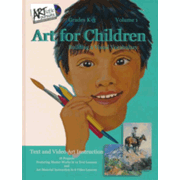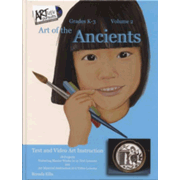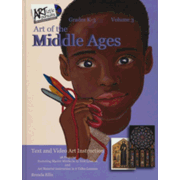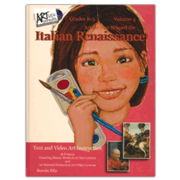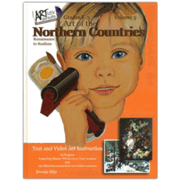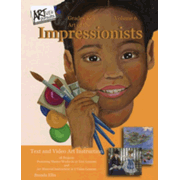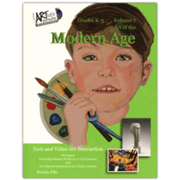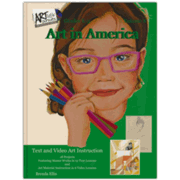Artistic Pursuits’ twelve-volume art instruction series has long been one of my favorites for teaching students of all ages. Now they have produced an eight-volume Text and Video Art Instruction series that is intended to be for students in kindergarten through third grade. In this new series, each book includes two DVDs. (Both DVDs present the same material, but one is standard and one is Blu-ray™.) An online option provides each complete course online with a "Flipping Book" and streamed video instruction. I was able to review the courses with books and DVDs.
This is a great series, but my impression is that the best age range is more likely grades one through eight as I will discuss further on. The publisher says that all students should begin with Volume 1: Art for Children, Building a Visual Vocabulary. The rest of the courses are based on historical periods. While it might be best to use them in chronological order, it is not necessary.
The courses are:
- Volume 1: Art for Children, Building a Visual Vocabulary
- Volume 2: Art of the Ancients (prehistoric art to AD 300)
- Volume 3: Art of the Middle Ages (AD 500 to 1300 in Europe)
- Volume 4: Art of the Italian Renaissance (1300-1600 in Italy)
- Volume 5: Art of the Northern Countries (1500-1800 in the Netherlands, France, and England)
- Volume 6: Art of the Impressionists (1830-1870 in France)
- Volume 7: Art of the Modern Age (20th century in Europe and the United States)
- Volume 8: Art in America (18th through 20th centuries in the United States
For each course, there are 18 projects, 12 text lessons, and six video lessons. According to the publisher, one of these courses should take one semester to complete, but you might spread out lessons with younger children so as not to overtax their attention spans.
The first course requires students to have the resources in the starter kit; most of these will be used in the other courses. The starter kit includes watercolor crayons, construction paper, a round brush, oil pastels, watercolor paper, sketch paper, a vinyl eraser, Fiskars® scissors, two sketching pencils, Elmer’s® Glue-All®, an Elmer’s® glue stick, and a tote bag. Each course uses some items from the starter kit along with some household items such as paper towels, masking tape, sidewalk chalk, and hairspray. After the first course, the other courses gradually teach the use of other art media.
Volume 1 introduces watercolor painting, watercolor crayons, oil pastels, and art projects requiring paper cutting and folding. The watercolor crayons are used frequently with the other courses, so I won’t list them again each time. Volume 2 teaches students how to use self-hardening clay and both oil and chalk pastels. In Volume 3, students work with an unusual selection of art media including gesso, tissue paper, Sculpey® clay, Mod Podge®, burlap, yarn, and gold origami paper. With Volume 4, students learn to work with a watercolor tray, gold origami paper, Scratch-Art® Paper, chipboard, and oil pastels. They also learn how to apply spackling paste on hardboard or cardboard as a base for fresco-style painting. Printmaking with ink and a brayer is introduced in Volume 5, along with work with charcoal, a watercolor pan, oil pastels, and 3-D landscapes created from construction paper. Volume 6 teaches students to use Gouache paint; carve soap; sculpt with modeling clay; and create figure sculptures using cardboard tubes, chipboard, plaster cloth, and gesso. In Volume 7, students are introduced to acrylic paints, creating a "robot" (from boxes, tubes, and other disposable items along with gesso and paint), modeling with aluminum foil, creating a plaster portrait (from an empty spray bottle, clay, aluminum foil, and plaster cloth), making an animated flipbook, and creating a relief sculpture with modeling clay.
With the first seven courses, children are not expected to reproduce realistic images in a consistent fashion. Volume 8 is a transition point where children learn to more accurately draw realistic images. To that end, the eighth course teaches sketching skills as children learn to work with both sketching and colored pencils.
The video lessons show how to work with each medium, and they always do so in the context of a project. There are usually two or more projects that follow each video lesson, giving students the opportunity to develop at least some skill with each medium. The projects are very creative. Most of the time, children get to decide the specific subject matter of their projects based on a general idea. For example, when children make a pastel drawing of an animal in the fifth lesson of Volume 2, their choice of what to draw is based on animal photos you supply.
The video lessons are hosted by Ariel Holcomb, with the actual teaching done by series author Brenda Ellis. Ariel often dresses in period costumes and helps make connections between the type of artwork and a historical period. Each video concludes with a brief review of the entire project before students tackle it themselves.
There’s more to these courses than art projects. The books include images of works by master artists that children reference for the study of design elements, techniques, arrangement, and their subject matter. Both the text and the video lessons often include information about how the particular type of art was used or what it represented in that time period.
Level of Difficulty
While the publisher says that courses beyond the first one can be used in any order, I think that it makes sense to follow the chronological arrangement if possible. There is also a gradual progression in difficulty from course to course with skills sometimes building upon previous skills. So, while you can use courses out of order, I wouldn’t recommend, for instance, jumping from Volume 1 to Volume 7. It also seems clear to me that Volume 8 should be used with older children; I would suggest at least fourth grade or above for that course.
Lessons in the textbooks sometimes show examples of projects done by students. Labels for these artworks show that students vary in age, but many projects were done by nine-year-olds. A few were done by ten- or eleven-year-olds, and a few were done by four-year-olds. This suggests that homeschoolers should be able to use them outside of the recommended grade levels as well.
The skills taught in Volume 1 are as basic as how to cut with scissors, how to use a glue stick, identifying shapes, and how to color within lines. But the actual art activities are flexible enough to engage children from beginners to those with more-advanced skills. The emphasis is on work with art media rather than drawing skills. For instance, the first course has children draw landscapes and still-life arrangements, but it doesn't teach drawing skills. So a young child might draw a very simple and unrealistic landscape while an older student might add elements that show things in the foreground or background.
Many projects ask students to draw human figures, although (as I mentioned before) there are no specific instructions about how to draw them until Volume 8. For example, the seventh lesson in Volume has students use watercolors to paint a human character based on a story including clothing they would be wearing. If they look only at the instructor's sample, students might find this difficult and intimidating, both because figures are hard to create and watercolor is a difficult medium for creating details. However, the student example for this project shows far less proficiency than does the professional example and is an easier sample to emulate.
So while the level of difficulty might seem challenging, students can still learn skills and experience a reasonable level of success if expectations are age-appropriate and realistic. As I mentioned at the beginning of this review, I would consider using these courses with students up through eighth grade because most of the projects present learning opportunities and challenges suitable for them as well as for younger students. However, you need to be aware that the program does not try to cover all of the educational art standards for students beyond third grade.
Summary
I really like these courses. The high-quality video instruction, coupled with textbooks and lots of hands-on projects, makes using these courses a great choice for parents and teachers who want to “see and do” without having to invest a lot of effort figuring out how to teach.










